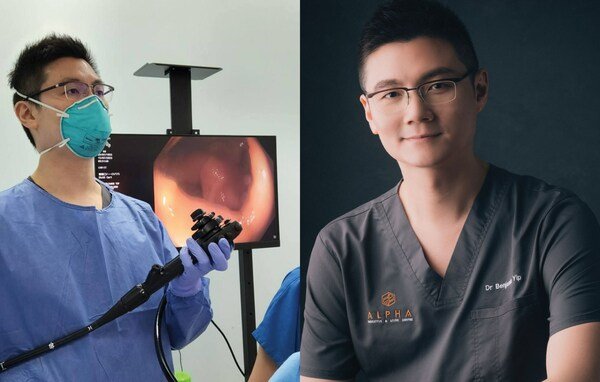Advanced Endoscopic Procedures: From Diagnosis to Minimally Invasive Treatments
05 May 2023 | Friday | News

"Advanced endoscopy" procedures are those which require additional training over and above general endoscopy procedures. These procedures provide a minimally invasive alternative to treating certain conditions that would have otherwise required conventional open surgery.
In this article, Dr Benjamin Yip, Consultant Gastroenterologist and Medical Director of Alpha Digestive & Liver Centre, tells us more about advanced endoscopic procedures and their potentially life-saving functions.
Endoscopic Ultrasound (EUS)
An endoscopic ultrasound (EUS) is a minimally invasive endoscopic procedure that involves the use of an ultrasound scanning probe attached to the tip of the endoscope. It allows the gastroenterologist to examine the lining of the upper (oesophagus, stomach and duodenum) and lower (sigmoid colon and rectum) gastrointestinal tract, as well as the structures next to the GI tract such as lymph nodes, tumours, collections, the pancreas, liver, gallbladder and bile duct.
Diagnostic purposes
EUS can be used to diagnose diseases, including:
- Bile duct stones
- Pancreatic cysts
- Any form of cancer in the digestive tract (oesophagus, stomach, rectum, pancreas)
- Any abnormal growths in the digestive tract (stomach, oesophagus, rectum)
- Lymphoma and enlarged lymph nodes in the abdomen and chest
- Tissue can also be obtained via fine-needle aspiration (biopsy) for a more detailed analysis to aid in diagnosis.
Therapeutic purposes
EUS can be used to treat certain medical conditions without the need to make a cut on the body and perform surgery. These include:
- Drainage of pancreatic cysts
- Aspiration of fluid-filled spaces in the abdomen
- Treating any bleeding in the digestive tract from a burst blood vessel
- For treatment of pancreatic diseases, via applying nerve blocks
- Various ablative therapies
In Dr Benjamin Yip's personal opinion, the EUS is a procedure tailor-made for the pancreas, which is a deep-seated abdominal organ often obstructed by other organs and structures.
For both diagnostic and therapeutic purposes, an EUS allows the gastroenterologist to access the pancreas (given the configuration of the stomach and duodenum) in a minimally invasive manner. Otherwise, access to the pancreas would generally be performed percutaneously (via the skin), which would often not be possible due to the inaccessibility of the pancreas.
Endoscopic Retrograde Cholangiopancreatography (ERCP)
Endoscopic retrograde cholangiopancreatography (ERCP) is an endoscopic procedure used to look at or treat the bile ducts, pancreatic ducts and gallbladder.
During the ERCP, a thin, flexible, and hollow tube with a camera attached at one end, called an endoscope, is inserted through the mouth and carefully moved into the digestive tract. The endoscope goes from the mouth to the oesophagus, stomach, and then lastly to the duodenum, the first part of the small intestine.
Diagnostic purposes
ERCPs may be used to evaluate certain conditions:
- Biliary tract abnormalities
- Dilation of the bile duct
- Bile duct obstruction (causes include gallstones)
- Evaluating narrowed segments, also known as strictures, of the bile ducts
- Cancer in the liver, pancreas, or gallbladder
- Infections of the bile ducts
- Primary sclerosing cholangitis
- A sample of tissue or cells may also be removed (biopsy/brushing) during the ERCP to be sent to the lab for further analysis by a pathologist
Therapeutic purposes
ERCPs may be used to treat certain conditions of the bile ducts and pancreatic ducts. It may also be used to treat complications after gallbladder or liver surgery.
- Gallstone extraction
- Insertion of a stent to relieve blockage
- Dilation of strictures
- Endoscopic sphincterotomy (opening up the entry of the ducts into the bowel)
- Drain blocked areas
Dr Benjamin Yip shares, "Although ERCP is one of the higher risk endoscopic procedures, it is usually well-tolerated. I had a patient in her 90's with incurable ampullary cancer, in which I did ERCP and inserted a biliary metal stent to prevent biliary blockage. I remember seeing her one year after the ERCP, and she remained well, and the stent was functioning well!"
Deep Enteroscopy
Deep enteroscopy is an incisionless procedure whereby a long endoscope is inserted into the gastrointestinal tract. A common type is balloon-assisted enteroscopy, which makes use of small balloons to allow an endoscope to effectively travel through the small intestine, which is typically hard to reach. After the endoscope is inserted through the mouth (antegrade approach), the balloons are alternately inflated and deflated, allowing movement through the gastrointestinal tract. For the retrograde approach, the endoscope is inserted through the anus.
On average, the small intestine is six metres long, making it difficult to reach using more-traditional endoscopy procedures. Deep enteroscopy works by "pleating" the intestine as the endoscope is threaded through it, which can be likened to pushing a rod through a curtain.
Diagnostic
Deep enteroscopy could be used as a diagnostic tool to:
- Find the cause of bleeding in the small intestine
- Detect and biopsy strictures (abnormal narrowings, inflammation or scar tissue)
- Detect and biopsy abnormal tissue
- Detect and biopsy polyps or tumours
Therapeutic
Deep enteroscopy serves a therapeutic purpose, and various miniature tools can be attached to the end of the endoscope to:
- Stop the bleeding
- Remove polyps within the small intestine
- Widen a stricture
- Remove a foreign body stuck in the small intestine
- Implant a stent to prevent the re-narrowing of a section in the small intestine
The small bowel used to be a "no man's land" for Gastroenterologists as they are deep within the abdomen and were difficult to reach with the instruments of the past. Nowadays, however, modern endoscopes with various capabilities allow the Gastroenterologist to access these difficult-to-reach areas — sometimes saving the patient from having to undergo surgery.
Most Read
- The New AI Gold Rush: Western Pharma’s Billion-Dollar Bet on Chinese Biotech
- Top 25 Biotech & Biopharma Leaders in Sustainable Innovation, 2025
- China’s Biopharma Dealmaking Surges in H1 2025, Driven by Record Licensing and Oncology Focus
- Chikungunya in China: How a “Forgotten” Arbovirus Found the Perfect Storm
- How Innovation Gaps in Biopharma Raise New Safety Concerns
- Smart Implants and the Future of Musculoskeletal Injury Treatment
- How Ethical Gaps in Psychiatry Could Undermine Biopharma Progress
- The Evolving Landscape of Women’s Health Innovation in the Asia-Pacific
- Using NLP-Driven Decision Support in Emergency Health Assistance
- Taiwan Steps Into the Global Spotlight With a New Cancer Therapy
- The Role of Unique Device Identification (UDI) in Tracing Medical Device Safety
- The Importance of a Patient’s Mental Health During Clinical Trials
Bio Jobs
- The State of Biotech and Life Science Jobs in Asia Pacific – 2025
- Avantor’s New CEO Ligner Aims to Unlock Global Potential and Deliver Shareholder Value
- AstraZeneca Commits $50 Billion to U.S. Expansion by 2030 in Biggest-Ever Global Investment
- Thermo Fisher, SAMRC, and South Africa’s Department of Science and Innovation Launch CATIR to Nurture Next-Gen Scientists
- Cube Biotech Appoints Former Sartorius CEO Dr. Joachim Kreuzburg to Board of Directors
- FDA’s AI Transition Marks a Turning Point in Drug Review: Industry Faces Pressure to Adapt Amid 20% Workforce Cut
- WuXi XDC Completes Mechanical Build of Singapore Bioconjugate Manufacturing Hub
News
Editor Picks











